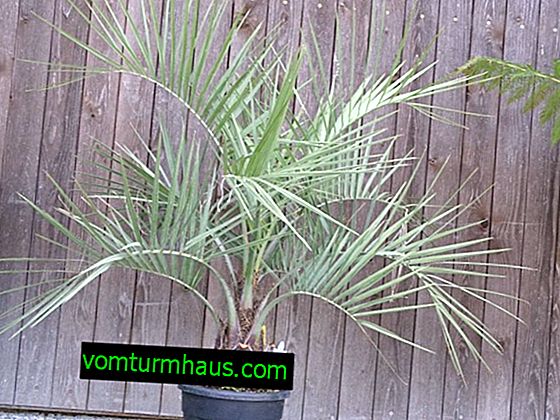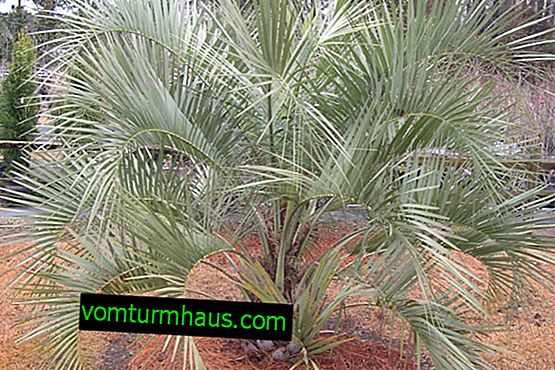Palm butia: home care
Many saw these palm trees, organically blending into any interior and decorating both public spaces of various profiles and private dwellings. But not everyone knows that these beauties come from South America and are called butia. This article will discuss the most popular and widespread capitate capitate, about the maintenance and care of it at home.
Botanical description of the plant
In the family of palm butium, it occupies a prominent place, having there 20 of its South American representatives in the form of cirrus palms, whose growth varies from 0.4 to 10 meters. The most famous among them is capitate butia (butia capitata), reaching six meters in height and half a meter in diameter.

| Root system | Developed |
| Stem | Powerful, gray in color at the bottom, thickening at the base, having a single growth point at the top |
| Leaf shape | Long arched, arcuate |
| Leaf color | Gray-green |
| Flower shape | Simple, small flowers |
| Flower color | Red |
| Fruit shape | Oval Drupe |
| Fruit color | Orange |
| Fruit flavor | Sweet and sour |
Did you know? From the earliest times, palm was considered a symbol of peace and victory. No wonder the dove of peace holds the palm branch in its beak, and the winners of sports have always been given the "palm."
The main types
As mentioned above, butium has 20 species. Among which the most famous are:
- the already mentioned capitate, which, in addition to the demanded decorative properties, has high culinary qualities of its fruits, which are successfully used in the preparation of wine and jelly;

- hairy-covering, whose intricate name hides a palm tree, similar to capitate, but less tall and with smaller and not so juicy fruits;

- Paraguayan, whose growth barely reaches 2 m and a trunk diameter of 0.12 m. It looks elegant with its lush crown of arched cirrus leaves. It produces 4-centimeter egg-shaped fruits that are not as tasty as capitate butia, but are still used in cooking;

- yatay, a native of Argentina. Very similar to capitate, but with smaller edible fruits of elongated shape.

House growing conditions
Capitate butia is cultivated at home quite actively, not only because of the attractive external surroundings, but also due to a certain unpretentiousness, which distinguishes it from most palm counterparts.




















Location
The unpretentiousness of this plant is especially manifested in its undemanding to bright lighting, that is, in a sufficiently high shade tolerance (although, like any other palm, capitate in good light feels more comfortable and grows more intensively). In summer, this plant is recommended to be taken out to fresh air, and in the absence of such an opportunity, regular ventilation of the room in which the palm tree grows should be carried out.
Did you know? Palm trees belong to plants, which, on the one hand, are very recognizable, and on the other hand, are extremely varied both in appearance and in productivity. Currently, there are 3400 species of palm trees on our planet alone.
Temperature
The most comfortable temperature for this plant varies between + 20 ° C— + 25 ° C, and in winter it can be reduced for adult palm trees to + 10 °, and for young palm trees to + 15 ° C.
Air humidity
The undemanding of the butia to the conditions of detention is also manifested in the humidity of the air, to which it is quite indifferent. However, during the summer heat, if the tips of the leaves begin to dry out on the plant, it is useful to spray it with soft water.

Home Care
It’s not difficult to take care of capitate capillary, but some efforts will still be required.
Watering
This is especially true for irrigation, which must be done regularly and in sufficient volume. It is possible to water the capitate palm only with soft and well-defended water at room temperature. This requirement is due to the fact that this plant does not tolerate the excessive presence of lime in the soil.
The irrigation frequency is affected by the degree of illumination of the plant and the ambient temperature. In bright light, stimulating the active development of the plant, and at a high temperature, accelerating the drying of the soil, water often. In winter, this is done much less frequently, but the soil should not completely dry out.
Important! It is the irrigation errors that can cause maximum harm to the palm, since an excess of moisture can lead to decay of the roots, and its lack causes damage to the entire root system of the plant.
Top dressing
During the active growth of the plant, several times every half a month it should be fertilized with complex palm top dressing, as well as fertilizers intended for decorative and deciduous plants. It is useful to deliver a small part of the fertilizer to the palm tree by spraying with a low percentage solution. In winter, top dressing is unnecessary.
Pruning
Like all other palms, capitate butia is not pruned.
Transfer
Recommended Reading

Since this palm tree does not like transplantation, this operation should be performed only if urgent need is needed no more than once every 4 years.
Do this in early spring, using a pot one third larger than the previous diameter, and slightly acidic soil with a pH of 5.0-6.0.
It is best to take special palm soil for this, but you can prepare it yourself by mixing 3 parts of leafy soil with 3 parts of turf and adding 1 part of river sand.
Before planting in the pot, the roots of the butia that create the felt layer should be trimmed. A layer of fine gravel must be laid at the bottom of the pot for drainage.
When transplanting, you can not bury the plant, you should leave the soil level at the same level. For comfortable growth, it is enough to replace the topsoil with 5 cm in depth once a year.
Seed cultivation
Butia is able to reproduce exclusively by seeds, which have a weak and stretched in time germination, which can be extended up to one year. To grow a palm tree from seeds, you must:
- Soak the seeds in water or using special stimulants for a couple of days.
- Carefully prick the seed from one side, in no case going deeper into its core.
- Plant the seed in the ground, pricked side down, not immersing it much in the soil.
- Cover the seeded tank with glass or film and put in a place with moderate lighting and a temperature of + 27- + 28 ° heat.
- Wait for seed germination, which can occur after 4 months, and after 6 and even 12. When the sprouts reach a height of 4 cm, they are planted in separate containers.

Growing difficulties
With all its sufficient unpretentiousness, capitate butia can sometimes cause its owners some problems, which are most often associated with their own oversight. These problems are expressed in:
- The appearance of brown spots on the leaves, which happens due to waterlogging of the soil or, conversely, its drying out. To eliminate the problem associated with waterlogging, you need to remove the earthen lump from the pot, eliminate rotten roots, sprinkle the cut with chopped charcoal and dry the lump. When drying, water the soil properly, without removing it from the pot, and at the same time palm leaves are abundantly sprayed with settled water. It is useful to use Zircon for watering and spraying.
- The appearance of a whitish hue on the leaves, which is associated with the activity of either a spider mite or thrips. First of all, it is necessary to rinse each sheet thoroughly on both sides with warm water. It is useful to use insecticides to control ticks, and acaricides to kill thrips.
- Weak growth of foliage or its complete absence, which is most often explained by poor lighting.
- Yellow or brown spots on the leaves in the summer, which, on the contrary, is caused by excessive lighting.
- Yellowing and drying of the tips of the leaves, provoked by insufficient watering.
Important! The dried palm leaves are not restored.
The capitate palm tree, which requires a spacious and well-ventilated room for its full development, otherwise does not put forward excessive requirements for maintenance, for which it is appreciated by the ever-expanding circle of its fans.







